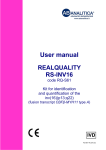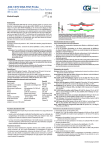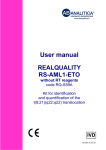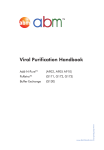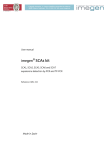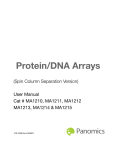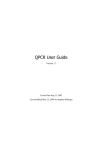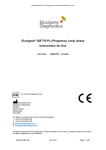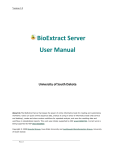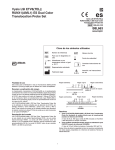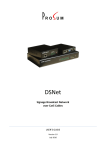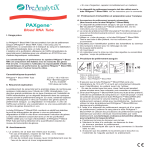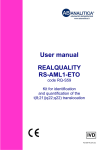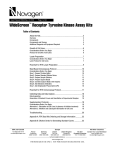Download Time is short Run a HemaVision®-28Q
Transcript
Time is short The list is not del1(p32) (STIL-TAL1) t(1;11) (p32;q23) (MLL-EPS15) t(1;11) (q21;q23) (MLL-MLLT11) t(1;19) (q23;p13) (TCF3-PBX1) t(3;5) (q25;q34) (NPM1-MLF1) t(3;21) (q26;q22) (RUNX1-MECOM) t(4;11) (q21;q23) (MLL-AFF1) t(5;12) (q33;p13) (ETV6-PDGFRB) t(5;17) (q35;q21) (NPM1-RARA) t(6;9) (p23;q34) (DEK-NUP214) t(6;11) (q27;q23) (MLL-MLLT4) t(8;21) (q22;q22) (RUNX1-RUNX1T1) t(9;9) (q34;q34) (SET-NUP214) t(9;11) (p22;q23) (MLL-MLLT3) t(9;12) (q34;p13) (ETV6-ABL1) t(9,22) (q34;q11) (BCR-ABL1) t(10;11) (p12;q23) (MLL-MLLT10) t(11;17) (q23;q21) (MLL-MLLT6) t(11;17) (q23;q21) (ZBTB16-RARA) t(11;19) (q23;p13.1) (MLL-ELL) t(11;19) (q23;p13.3) (MLL-MLLT1) t(12;21) (p13;q22) (ETV6-RUNX1) t(12;22) (p13;q11) (ETV6-MN1) t(15;17) (q24;q21) (PML-RARA) inv(16) (p13;q22) (CBFB-MYH11) t(16;21) (p11;q22) (FUS-ERG) t(17;19) (q22;p13) (TCF3-HLF) t(X;11) (q13;q23) (MLL-FOXO4) Cat. No. HV01-28Q Run a HemaVision®-28Q 28 Translocations 145+ Breakpoints In just 4 hours IVD USER MANUAL Revision date 2015.09.30 www.dna-diagnostic.com 1 USER MANUAL HEMAVISION®-28Q Cat. No. HV01-28Q A MULTIPLEX RT-QPCR TEST FOR SCREENING OF 28 LEUKEMIA-ASSOCIATED TRANSLOCATIONS 12 TESTS PER KIT IVD FOR PROFESSIONAL USE ONLY MANUFACTURER: DNA Diagnostic A/S Voldbjergvej 16 8240 Risskov Denmark Homepage: www.dna-diagnostic.com Email: [email protected] Phone: 0045 87323050 TRADEMARKS AND LICENSES: HemaVision is a registered trade mark of DNA Diagnostic A/S. Cy5 is a registered trade mark of GE Healthcare. Mx3005P, Stratagene and Agilent are registered trademarks of Agilent Technologies, Inc. Black Hole Quencher® (BHQ®), CAL Fluor® and Quasar® dye technology incorporated in this product are used under licensing agreement with Biosearch Technologies, Inc. and protected by U.S. and world-wide patents issued or in application. TABLE OF CONTENTS 1. PURPOSE OF THE TEST.................................................................................................... 3 2. PRINCIPLES OF TEST........................................................................................................ 4 3. KIT COMPONENTS AND STORAGE................................................................................... 5 4. REQUIRED EQUIPMENT................................................................................................... 5 5. PRECAUTIONS................................................................................................................. 6 6. PROTOCOL AT A GLANCE................................................................................................ 6 7. DETAILED PROTOCOL...................................................................................................... 7 Step 7.1 RNA Preparation.............................................................................................. 7 Step 7.2 cDNA Synthesis................................................................................................ 7 Step 7.3 qPCR................................................................................................................. 7 Step 7.4 Analysis & Interpretation................................................................................. 8 8. INTERPRETATION TABLE................................................................................................. 12 9. HGNC GENE NAMES AND NCBI ACCESSION NUMBERS.................................................. 14 2 HemaVision®-28Q 1. PURPOSE OF THE TEST HemaVision®-28Q is a 4 hour CE IVD marked in vitro diagnostic test for qualitative screening of 28 chromosome translocations involved in chronic and acute leukemia. The amplification plot allows professionals to react rapid and with precision in terms of treatment planning, while profiting from the costand labour-effective screening process. HemaVision®-28Q provides a rapid screen for 28 translocations with more than 145 clinically relevant chromosomal breakpoints. The test requires only limited hands on time and the procedure can be completed in 4 hours after RNA extraction. HemaVision®-28Q detects RNA transcripts from fusion genes using a RT-qPCR procedure. Alternative splice variants are also detected. HemaVision®-28Q detects the following 28 translocations: del1(p32) (STIL-TAL1) t(1;11) (p32;q23) (MLL-EPS15) t(1;11) (q21;q23) (MLL-MLLT11) t(1;19) (q23;p13) (TCF3-PBX1) t(3;5) (q25;q34) (NPM1-MLF1) t(3;21) (q26;q22) (RUNX1-MECOM) t(4;11) (q21;q23) (MLL-AFF1) t(5;12) (q33;p13) (ETV6-PDGFRB) t(5;17) (q35;q21) (NPM1-RARA) t(6;9) (p23;q34) (DEK-NUP214) t(6;11) (q27;q23) (MLL-MLLT4) t(8;21) (q22;q22) (RUNX1-RUNX1T1) t(9;9) (q34;q34) (SET-NUP214) t(9;11) (p22;q23) (MLL-MLLT3) t(9;12) (q34;p13) (ETV6-ABL1) t(9,22) (q34;q11) (BCR-ABL1) t(10;11) (p12;q23) (MLL-MLLT10) t(11;17) (q23;q21) (MLL-MLLT6) t(11;17) (q23;q21) (ZBTB16-RARA) t(11;19) (q23;p13.1) (MLL-ELL) t(11;19) (q23;p13.3) (MLL-MLLT1) t(12;21) (p13;q22) (ETV6-RUNX1) t(12;22) (p13;q11) (ETV6-MN1) t(15;17) (q24;q21) (PML-RARA) inv(16) (p13;q22) (CBFB-MYH11) t(16;21) (p11;q22) (FUS-ERG) t(17;19) (q22;p13) (TCF3-HLF) t(X;11) (q13;q23) (MLL-FOXO4) 3 HemaVision®-28Q 2. PRINCIPLES OF THE TEST HemaVision®-28Q is a RT-qPCR based assay for detection of leukemia associated fusion gene transcripts in total RNA from whole blood or bone marrow samples. Included in the kit are ready to use cDNA and qPCR Master Mixes. cDNA is synthesized by adding purified RNA to the HemaVision®-28Q ready to use cDNA reaction mix. The resulting cDNA is added to 23 ready to use qPCR reaction tubes, which contain specific PCR primers and probes for detection of fusion genes, three reference genes and an internal amplification control (IAC). The qPCR is performed in a real-time qPCR instrument with optical filters for detection of FAM, ROX, and CY5 fluorescence. Amplification plots and Ct (cycle at threshold) values are used for identification of the translocation and fusion gene transcript using an easy to use interpretation table. HemaVision®-28Q detects fusion gene transcripts using specific PCR primers and probes. The translocation specific primers bind to exons in the fusion gene enabling amplification of the region containing the breakpoint. The primers are designed to detect multiple clinical relevant breakpoints and splice variants (Figure 1). The qPCR master mix probes are dual labeled with a fluorophore and a quencher molecule at each end of the oligoes. During the annealing step of the PCR the probe bind to the PCR products of the previous rounds. Signals are generated in the subsequent elongation step as the 5’->3’exonuclease activity of the Taq polymerase enzyme degrades the hybridized probe. This liberates the fluorophore from the quencher, which thereby increases the fluorescence. The fluorescence is measured at the end of the elongation step of every PCR cycle. When the fluorescence for a translocation exceeds the threshold level before cycle 35 (Ct <35) the test is positive. The qPCR’s are multiplexed by the use of FAM, ROX and CY5 labeled probes. This permits two translocation tests and the IAC to run in the same tube. The identity of a positive translocation test is easily deduced from the Interpretation Table. As a control for the functionality of the qPCR reaction and for correct transfer of cDNA aliquots to the 23 qPCR reactions, an Internal Amplification Control (IAC) is included in the cDNA reaction mix. HemaVision®-28Q also includes primers and probes for detection of the reference gene transcripts ABL-1, B2M and GUS. Detection of the reference genes is a control for the integrity of the RNA sample and functionality of both cDNA and qPCR reactions. BCR m-bcr M-bcr ABL1 µ-bcr Tube 13 Tube 14 Tube 15 Figure 1. Primers and probes in HemaVision®-28Q are designed to detect multiple clinical relevant breakpoints. In this example primers and probe for detection of t(9;22) fusion gene transcript BCR-ABL1 are shown. Primers are depicted as blue arrows, FAM and ROX labeled probe as green and red lines and breakpoints as black triangles. Exons are numbered for the fusion genes BCR and ABL1. The three breakpoint regions (m-bcr, M-bcr , µ-bcr) of BCR are detected with the primer and probe combination of qPCR tube 13, 14 and 15, respectively. 4 HemaVision®-28Q 3. KIT COMPONENTS AND STORAGE HemaVision®-28Q contains reagents for 12 tests. Included in HemaVision®-28Q kit is the following components: • 12 cDNA tubes with 42 uL reaction mix (0.65 mL tubes with yellow screw cap) • 12 blocks of 24 qPCR tubes containing 23 uL qPCR reaction mix. • 12 extra set of optical caps for the qPCR tubes. • Two tubes with RNase free H2O (0.65 mL tubes with blue screw cap) • One user manual HemaVision®-28Q is produced in 3 formats to suit various qPCR apparatus. The qPCR mix can be supplied in 0.1 mL white low profile (WLP), 0.2 mL white regular profile (WRP) or 0.2 mL frosted regular profile (FRP) PCR tubes. Adaptor plates can be supplied with the kit if the qPCR instrument requires a 96-tube plate format (e.g. Roche LightCycler 480 and some ABI models). The cDNA reaction tubes contain reverse transcriptase, nucleotides, buffer, cDNA primers and IAC oligo template. The qPCR tubes contain hot start Taq DNA polymerase, nucleotides, buffer and primers/probes. Tube no. 1-6, 9-15, 17-23 contain primers and probes for both fusion genes and the IAC template. Tube no. 7, 8, 16, contain primers and probes for a reference gene and the IAC template. Tube no. 24 is empty. To confirm the orientation of the PCR strips after qPCR analysis check for FAM amplification signals in tube no. 7, 8, 16, and the absence of Cy5 amplification signal in tube no. 24. The kit must be stored at -20°C. Avoid thawing and freezing of the kit. The qPCR tubes must be protected from strong light to avoid bleaching of the probes. 4. REQUIRED EQUIPMENT • Centrifuge for 96 well plates or PCR 8-tube strips. • Thermal Heating Block. • A qPCR instrument with filters for FAM (Abs 495 nm, Em 520 nm), ROX (Abs 585 nm, Em 605 nm) and CY5 (Abs 635 nm, Em 665 nm). • Pipettes and sterile RNase free filtered tips. • Gloves 5 HemaVision®-28Q 5. PRECAUTIONS • The quality and concentration of the RNA sample greatly affects the results of this test. To minimize the risk of degradation by ribonucleases, we strongly recommend purification of total RNA immediately after blood (bone marrow) extraction. Do not freeze Ficoll purified cells without adding a denaturing solution [e.g. containing guanidinium isothiocyanate (GTC)] immediately after isolation and before freezing. Always store cell samples and aqueous RNA solutions at -80°C. Even an overnight storage at 20°C may result in RNA degradation. • When working with RNA always use gloves, as hands are a major source of ribonuclease contamination. • The high sensitivity of DNA amplification techniques makes the reactions susceptible to DNA contamination from previous amplification reactions, potentially resulting in false positive results. To minimize the risk of contamination avoid opening qPCR tubes after amplification. • Laboratory workbenches and pipettes must be cleaned with bleach on a regularly scheduled basis. • Use aerosol barrier pipette tips. 6. PROTOCOL AT A GLANCE 1: RNA denaturation 18 uL total RNA (0.15-1.5 ug) ▼ 65°C / 5 min ▼ 0°C / 1 min ▼ Spin / 1 min 2: cDNA synthesis Transfer to one cDNA tube ▼ Mix and spin / 1 min ▼ 42°C / 60 min ▼ 95°C / 5 min ▼ 0°C / 1 min ▼ Spin / 1 min 3: Add cDNA to qPCR tubes Spin 3x8-tube block 10 seconds ▼ Remove and discard lids ▼ Add 2 uL cDNA to each of the 23 qPCR mixes ▼ Close tubes with new optical lids ▼ Spin / 1 min 4: Program qPCR Instrument 1 cycle: 95°C / 15 min ▼ 40 cycles: 95°C / 30 sec 60°C / 50 sec 72°C / 80 sec* 5: qPCR analysis Generate amplification plots and use Interpretation Table *read FAM, ROX, CY5 Figure 2. Overview of HemaVision®-28Q protocol. 6 HemaVision®-28Q 7. DETAILED PROTOCOL 7.1 RNA Preparation Total RNA is extracted from blood or bone marrow cells. A minimum of 0.15 μg total RNA with a minimum concentration of 8 ng/μL RNA is needed for the subsequent steps. Due to the inherent instability of RNA use patient samples as fresh as possible. Blood samples can be stabilized in Paxgene Blood RNA tubes, Cat. No. BD762165. Do NOT use Heparin for stabilization of blood samples. Total RNA should be stored at -80°C. 7.2 cDNA Synthesis • Incubate total RNA at 65°C for 5 minutes and cool immediately on ice. Spin tube for 1 minute to collect condensate. • Take one yellow capped tube with cDNA master mix from the HemaVision®-28Q kit stored at -20°C. Add 18 μL (0.15-1.5 μg) of denatured total RNA to the cDNA master mix tube (tube with yellow cap). If necessary the RNA sample can be diluted with the provided RNase free H2O (tube with blue cap). Mix and spin for 1 minute. • Incubate the cDNA reaction at 42°C for 60 minutes. • Inactivate Reverse Transcriptase enzyme by heating to 95°C for 5 minutes. • Cool the cDNA reaction tube on ice for 1 minute and spin it again for 1 minute to collect condensate. 7.3 qPCR • For each cDNA sample use one block of 3x8-tube qPCR master mix tubes. Spin the 3x8 tubes for 10 second to collect qPCR master mix at the bottom of tubes. • Remove and discard the caps from one block of 3x8-tubes. Be careful not to separate the three 8-tube strips from each other. Also, be careful to avoid cross contamination and spill of reaction mixes while removing the caps. • Add 2 μL cDNA reaction to each of the 23 tubes containing 23 μL qPCR master mix (tube 1-23). Tube number 24 is empty and is used for orientation of the 3x8 tube block, see figure 3. o o o 1 9 17 2 10 18 3 11 19 4 12 20 5 13 21 6 14 22 7 15 23 8 16 24 o o o Figure 3. Positions of the 23 qPCR master mixes in each block of 3 x 8 tubes. Tube number 24 is empty and can be used for orientation of the 24 tube block. The hole in the upper right corner of each 8-tube strip (depicted as o ) marks the beginning of the strip and the centered hole marks the end of the strip. The tube numbering refers to the tube numbering in the Interpretation table. 7 HemaVision®-28Q • Close the 24 tubes with a fresh set of optical caps (supplied with the kit). Use gloves to avoid grease and dust on the optical caps. • Place the 3x8-tube block into the qPCR instrument. • Run the qPCR reaction with the following program: Step Time/Temperature Cycles Comment 1 15 minutes / 95°C 1 Activation of Taq Polymerase DNA amplification 30 seconds / 95°C 2 50 seconds / 60°C 80 seconds / 72°C * 40 * Read fluorescence for FAM, ROX and CY5 at the end of each extension step 7.3.1 Important notes for ABI 7500 and ViiA7 users • Ramp speed: Use standard ramp speed (not fast mode). • Targets: While defining the 3 targets FAM, ROX and CY5 choose for all targets “None” as Quencher. • Passive reference dye: Select “None” instead of “ROX” as passive reference dye. 7.3.2 Important notes for Roche LightCycler 480 users A Color Compensation (CC) file should be generated before the first run on the Light Cycler 480 and if the lamp has been replaced. A CC-kit with FAM, ROX and CY5 dye is available from DNA Diagnostic. qPCR software setup: • Set the ramp speed to 2.2 C/sec for annealing step and 4.4 C/sec for the remaining steps. • For the amplification step of the PCR program, under Analysis Mode choose Quantification and Acquisition Mode: Single. • Filter choice: Manually choose FAM, Red 610 and CY5. 7.4 Analysis and Interpretation Generate amplification plots showing: • Thermal cycles on the X-axis. • Background subtracted fluorescence on the Y-axis. The exact name on the Y-axis differs among qPCR instruments. See table 1. 8 HemaVision®-28Q Instrument Y-axis on amplification plot with background subtracted fluorescence ABI: 7500, ViiA7 ΔRn BioRad: CFX96 RFU Roche: Light Cyclers 480 Fluorescence (using Analysis option: Abs Quant / 2nd Derivative Max for All Samples) Qiagen: Rotor-Gene Norm. Fluoro. Agilent: Mx3000P / Mx3005P dR Table 1. Examples of instrument nomenclature for the Y-axis when the amplification plot shows background subtracted fluorescence. Figure 4. Amplification plot from Agilent Mx3005P with X-axis showing cycle number and Y-axis showing background subtracted fluorescence. The threshold line is used to find the Ct value. Ct is the intersection between the amplification curve and the threshold line. The threshold line is set just above the base line in this example resulting in a Ct value of 24.4. Ct values are calculated automatically by the instrument. The algorithms used to calculate Ct values differ between qPCR instrument software packages. The threshold line in the amplification plot should be set manually to allow accurate Ct determination. The threshold line should be set just above the background fluorescence, so that the threshold line intersects the amplification curves when the fluorescence increases due to PCR amplification. The threshold level should however be set sufficiently high to allow for fluctuations in background fluorescence and background fluorescence drift (a linear increase in fluorescence). The threshold level can be set manually using the following the steps: ABI; 7500, 7500 Fast, ViiA 7: In the Analysis window, choose “Plot Type: deltaRn vs Cycle”, and “Graph Type: Linear”. Unmark “Auto Threshold” and “Auto Baseline”. Then click “Show Threshold” and with the mouse move the threshold line above the baseline. Bio-Rad CFX96: Click the “Settings” tab, choose “Baseline Setting” and “Baseline Subtracted Curve Fit”. Using the mouse adjust the threshold level above baseline. Qiagen Rotor-Gene Q: Click “Analysis”, choose the fluorescence to analyze, click “Linear Scale”, “Slope Correct” and “Auto-Scale”. In the right side panel, under “CT Calculation”, click the button next to “Threshold” and mark the threshold level on the amplification plot. Roche LightCycler480: Choose “Absolut Quantification” and “Fit Points”. Then click the tab “Noise Band” and click the “Noiseband” drop down button and choose “Noiseband (Fluoresc)”. Use the mouse to set the Noise Band. Agilient MxPro: The automatic threshold level can be used. Choose “Adaptive Baseline Correction” and “Background-based Threshold” using cycle 6-11 and a sigma multiplier of 10. 9 HemaVision®-28Q Note! The Ct values cannot be used for exact quantification of the fusion transcripts level since the fusion gene amplicons differ in length, resulting in different PCR efficiencies. Check that a CY5 signal is present from the Internal Amplification Control (IAC) in tubes no. 1-23. The IAC CY5 fluorescence should yield Ct values between 29 and 34. This is a control for functionality of the qPCR reaction. If no CY5 signals are detected the test has failed either due to no addition of cDNA to the qPCR tube(s), incorrect instrument settings or evaporation from the qPCR tube(s). Repeat the test. Due to competition for PCR constituents CY5 Ct value above 34 may occur when the tube is also positive for FAM or ROX fluorescence. Check the Ct values for GUS, B2M and ABL1. The Ct values should be below: 28 in tube 7 (GUS), 25 in tube 8 (B2M), and 29 in tube 16 (ABL1). This is a control for RNA extraction and cDNA synthesis have been functional. GUS, B2M and ABL1 Ct values higher than the above mentioned values indicates that the quality of the RNA may be too low to generate a valid test result. Repeat test with fresh RNA. Check for a FAM or ROX signal with a Ct value below 35 in the “translocation” tubes 1-6, 9-15, 17-23. Translocation tests with Ct values below 35 for FAM and ROX signals and amplification curves with exponential growth can be considered as true positive. Use the Interpretation Table to identify the specific translocation. Ct values above cycle 35 for FAM and ROX signals may be the result of unspecific amplification (false positive). Repeat the test to confirm or reject the result. When the second test is negative, the sample is negative for the translocation observed in the first test. When the second test is also positive, the sample may be positive for the corresponding translocation. However, we highly recommend using other diagnostic techniques to confirm the result from positive tests having Ct values above 35. 10 HemaVision®-28Q Flowchart for data interpretation: Tube 1-23 All CY5 positive Note: One of the tubes may be CY5 negative when the same tube is positive for either ROX or FAM. Tube 7, 8, 16 FAM Ct values below 29, 28, 26, 25, 31 respectively 29 Test OK FAM or ROX positive (Ct<35) in any other tubes than 7, 8, 16 ? Tube 7, 8, 16 FAM negative or Ct values too high Test failed due to: Poor RNA quality Tube 1-23 CY5 negative Test failed due to: No cDNA added to qPCR reaction(s) Incorrect qPCR instrument setup Retest Incorrect cDNA setup Retest No: Negative for translocation Yes: Positive for a translocation. Proceed to Interpretation Table 11 HemaVision®-28Q a b 8: B2M CY5 FAM 1-23: IAC 7: GUS 16: ABL1 d c FAM 4: PML-RARA (bcr3) ROX 1-23 Figure 5. Example of amplification plots from a HemaVision®-28Q test. a) The CY5 amplification plot shows all 23 IAC control curves are present and have Ct values near 32. This serves as a positive control for correct transfer of 2 µL cDNA to all 23 qPCR tubes and functionality of the qPCR reactions. b) The FAM amplification plot for the reference genes B2M, GUS, and ABL1 in tubes 8, 7, 16 all show curves with Ct below 25, 28, and 29 respectively. This is positive a control for both the RNA quality and the RT-qPCR reactions were functional. c) The FAM amplification plot for tube 4 shows an amplification curve with a Ct value below 35. Therefore, the test is positive for t(15;17)(q24;q21)(PML-RARA, bcr3, S-form). See Interpretation Table. d) The ROX amplification plot shows no amplification for the tubes 1-23. Therefore, the test is negative for “ROX amplicons”. 12 HemaVision®-28Q 8. INTERPRETATION TABLE Tube Translocation Fusion Gene Fw primer - Rev primer Flourochrome t(15;17)(q24;q21) PML-RARA (bcr2, V) PML ex5-RARA ex3 FAM CY5 inv(16)(p13;q22) CBFB-MYH11 CBFB ex3-MYH11 ex30 ROX CY5 inv(16)(p13;q22) CBFB-MYH11 CBFB ex4-MYH11 ex34 FAM CY5 t(8;21)(q22;q22) RUNX1-RUNX1T1 RUNX1 ex6-RUNX1T1 ex3 ROX CY5 t(15;17)(q24;q21) PML-RARA (bcr1, L) PML ex6a-RARA ex3 FAM CY5 t(9;11)(p22;q23) MLL-MLLT3 MLL ex7-MLLT3 ex7 ROX CY5 t(15;17)(q24;q21) PML-RARA (bcr3, S) PML ex3-RARA ex3 FAM CY5 t(9;11)(p22;q23) MLL-MLLT3 MLL ex8-MLLT3 ex11 ROX CY5 t(11;19)(q23;p13.1) MLL-ELL MLL ex7-ELL ex3 FAM CY5 t(16;21)(p11;q22) FUS-ERG FUS ex6-ERG ex14 ROX CY5 t(12;22)(p13;q11-12) ETV6-MN1 ETV6 ex2-MN1 ex2 FAM CY5 t(6;9)(p23;q34) DEK-NUP214 DEK ex9-NUP214 ex19 ROX CY5 7 Reference gene GUS GUS ex11-GUS ex12 FAM CY5 8 Reference gene B2M B2M ex2-B2M ex4 FAM CY5 t(1;11)(p32;q23) MLL-EPS15 MLL ex8+9-EPS15 ex3 FAM CY5 t(6;11)(q27;q23) MLL-MLLT4 MLL ex8+9-MLLT4 ex2 ROX CY5 t(1;19)(q23;p13) TCF3-PBX1 TCF3 ex16-PBX1 ex3 FAM CY5 t(12;21)(p13;q22) ETV6-RUNX1 ETV6 ex5-RUNX1 ex4b ROX CY5 t(11;19)(q23;p13.3) MLL-MLLT1 MLL ex8+9-MLLT1 ex2 FAM CY5 t(4;11)(q21;q23) MLL-AFF1 MLL ex8+9-AFF1 ex9 ROX CY5 t(17;19)(q22;p13) TCF3-HLF TCF3 ex14-HLF ex4 FAM CY5 del(1)(p32) STIL-TAL1 STIL ex1-TAL1 ex1 ROX CY5 t(9;22)(q34;q11) BCR-ABL1 (m-bcr, P190) BCR ex1-ABL1 ex3 FAM CY5 t(9;9)(q34;q34) SET-NUP214 SET ex9-NUP214 ex19 ROX CY5 t(11;19)(q23;p13.3) MLL-MLLT1 MLL ex7-MLLT1 ex9 FAM CY5 t(9;22)(q34;q11) BCR-ABL1 (M-bcr, P210) BCR ex12-ABL1 ex3 ROX CY5 t(9;22)(q34;q11) BCR-ABL1 (µ-bcr, P230) BCR ex19-ABL1 ex3 FAM CY5 t(11;17)(q23;q21) ZBTB16-RARA ZBTB16 ex4-RARA ex3 ROX CY5 Reference gene ABL1 ABL1 ex2-ABL1 ex3 FAM CY5 t(9;12)(q34;p13) ETV6-ABL1 ETV6 ex2+5-ABL1 ex3 FAM CY5 t(5;12)(q33;p13) ETV6-PDGFRB ETV6 ex2+5-PDGFRB ex12 ROX CY5 t(10;11)(p12;q23) MLL-MLLT10 MLL ex8+9-MLLT10 ex20 FAM CY5 t(1;11)(q21;q23) MLL-MLLT11 MLL ex8+9-MLLT11 ex2 ROX CY5 t(X;11)(q13;q23) MLL-FOXO4 MLL ex7-FOXO4 ex2 FAM CY5 t(11;17)(q23;q21) MLL-MLLT6 MLL ex7-MLLT6 ex12 ROX CY5 t(3;21)(q26;q22) RUNX1-MECOM RUNX1 ex6-MECOM ex2 FAM CY5 t(10;11)(p12;q23) MLL-MLLT10 MLL ex7-MLLT10 ex9 ROX CY5 t(5;17)(q35;q21) NPM1-RARA NPM1 ex4-RARA ex3 FAM CY5 t(3;5)(q25.1;q35) NPM1-MLF1 NPM1 ex4-MLF1 ex4 ROX CY5 t(10;11)(p12;q23) MLL-MLLT10 MLL ex7-MLLT10 ex13 FAM CY5 1 2 3 4 5 6 9 10 11 12 13 14 15 16 17 18 19 20 21 22 t(3;21)(q26;q22) RUNX1-MECOM RUNX1 ex6-MECOM ex9 ROX CY5 23 t(10;11)(p12;q23) MLL-MLLT10 MLL ex8-MLLT10 ex12 ROX CY5 24 - - - - - 13 HemaVision®-28Q When more than one of the tubes 1-6, 8-15, 17-23 are positive for FAM or ROX interpretate as follows: Positive tubes 1 (ROX) 2 (FAM) 1 (FAM) 3 (FAM) 4 (FAM) 1 (FAM) 3 (FAM) Interpretate as tube 1 (ROX): Inv(16)(CBFB-MYH11) 3 (FAM): t(15;17)(PML-RARA), bcr1, L-form 3 (FAM): t(15;17)(PML-RARA), bcr1, L-form 1 (FAM) 4 (FAM) 1 (FAM): t(15;17)(PML-RARA), bcr2, V-form 3 (ROX) 4 (ROX) 3 (ROX): t(9;11)(MLL-MLLT3) 11 (FAM) 14 (FAM) 14 (FAM): t(11;19)(MLL-MLLT1) 13 (FAM) 14 (ROX) 14 (ROX): t(9;22)(BCR-ABL1), M-bcr, P210 20 (ROX) 22 (FAM) 22 (FAM) 23 (ROX) 20 (ROX): t(10;11)(MLL-MLLT10) 23 (ROX): t(10;11)(MLL-MLLT10) Fusion genes targeted with more than one pair of amplification primers may result in positive signals in more than one tube. Use table above in combination with Interpretation Table to identify the breakpoint. 14 HemaVision®-28Q 9. HGNC GENE NAMES AND NCBI ACCESSION NUMBERS Old Abbreviation HGNC Abbreviation Chromosome HGNC ID NCBI Accession ABL ABL1 9q34.1 HGNC:76 NG_012034.1 AF10 MLLT10 10p12 HGNC:16063 NG_027818.1 AF17 MLLT6 17q21 HGNC:7138 NM_005937.3 AF1p EPS15 1p32 HGNC:3419 NM_001981.2 AF1q MLLT11 1q21 HGNC:16997 NM_006818.3 AF4 AFF1 4q21.3 HGNC:7135 NM_001166693.1 AF6 MLLT4 6q27 HGNC:7137 NM_001207008.1 AF9 MLLT3 9p22 HGNC:7136 NM_004529.2 AFX1 FOXO4 Xq13.1 HGNC:7139 NM_005938.3 AML1 RUNX1 21q22.3 HGNC:10471 NG_011402.2 BCR BCR 22q11 HGNC:1014 NG_009244.1 CAN NUP214 9q34 HGNC:8064 NG_023371.1 CBFβ CBFB 16q22.1 HGNC:1539 NG_009281.1 DEK DEK 6p23 HGNC:2768 NM_003472.3 E2A TCF3 19p13.3 HGNC:11633 NG_029953.1 ELL ELL 19p13.1 HGNC:23114 NM_006532.3 ENL MLLT1 19p13.3 HGNC:7134 NM_005934.3 ERG ERG 21q22.3 HGNC:3446 NG_029732.1 ETO RUNX1T1 8q22 HGNC:1535 NG_023272.2 FUS FUS 16p11.2 HGNC:4010 NG_012889.2 HLF HLF 17q22 HGNC:4977 NM_002126.4 MDS1-EVI1 MECOM 3q26 HGNC:3498 NG_028279.1 MLF1 MLF1 3q25 HGNC:7125 NG_027720.1 MLL MLL 11q23 HGNC:7132 NG_027813.1 MN1 MN1 22q12.1 HGNC:7180 NG_023258.1 MYH11 MYH11 16p13.11 HGNC:7569 NG_009299.1 NPM NPM1 5q35 HGNC:7910 NG_016018.1 PBX1 PBX1 1q23.3 HGNC:8632 NG_028246.1 PDGFRβ PDGFRB 5q31-q32 HGNC:8804 NG_023367.1 PLZF ZBTB16 11q23 HGNC:12930 NG_012140.1 PML PML 15q24 HGNC:9113 NG_029036.1 RARα RARA 17q21 HGNC:9864 NM_000964.3 SET SET 9q34 HGNC:10760 NG_030356.1 SIL1 STIL 1p32 HGNC:10879 NG_012126.1 Tal1 TAL1 1p32 HGNC:11556 NM_003189.2 TEL ETV6 12p13 HGNC:3495 NG_011443.1 TLS FUS 16p11.2 HGNC:4010 NG_012889.2 The HUGO Gene Nomenclature Committee (HGNC) approves a unique and meaningful name for every known human gene. The table contains a list of all relevant genes for the HemaVision®-28Q kit, with the old gene name abbreviation and the corresponding HGNC abbreviation. Furthermore the table contains the NCBI (www.ncbi.nlm.nih.gov/nucleotide) accession numbers for the gene or transcript sequences targeted by HemaVision®28Q primers and probes. HemaVision®-28Q 15 Run a HemaVision®-28Q Availability & questions Our team and distributors are always at hand to answer your questions. Contact us to find your nearest HemaVision® partner. For more information, contact DNA Diagnostic A/S Voldbjergvej 16 8240 Risskov Denmark Tel. +45 87 32 30 50 Fax +45 87 32 30 59 [email protected] www.dna-diagnostic.com DNA Diagnostic A/S (previously named DNA Technology A/S) was established in 1992. DNA Diagnostic A/S is an ISO 13485:2012 certified developer, manufacturer, and worldwide supplier of PCR based CE IVD marked in vitro diagnostic kits. Cat. No. HV01-28Q [email protected] USER MANUAL www.dna-diagnostic.com 16 HemaVision®-28Q

















